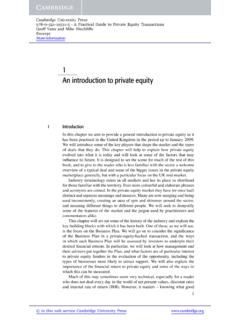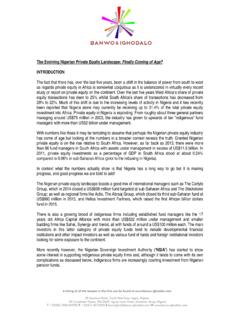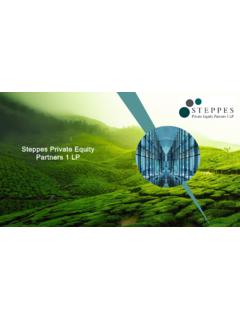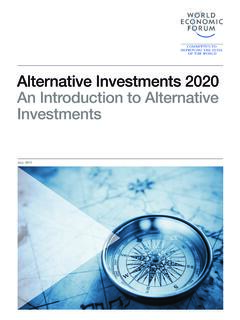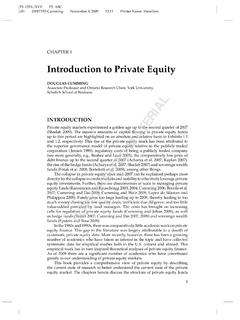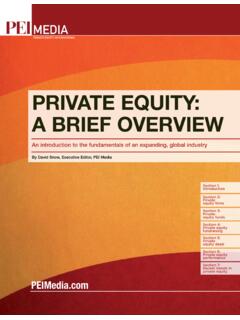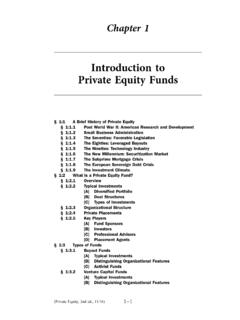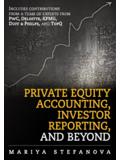Transcription of Introduction to Private Introduction to Private Equity ...
1 1 1( Private Equity , Rel. #2, 11/18)Chapter 1 Introduction to Private Equity Funds 1:1 A Brief History of Private Equity 1 Post World War II: American Research and Development 1 Small Business Administration 1 The Seventies: Favorable Legislation 1 The Eighties: Leveraged Buyouts 1 The Nineties: Technology Industry 1 The New Millennium: Securitization Market 1 The Subprime Mortgage Crisis 1 The European Sovereign Debt Crisis 1 The Investment Climate 1:2 What Is a Private Equity Fund? 1 Overview 1 Typical Investments[A] Diversified Portfolio[B] Deal Structures[C] Types of Investments 1 Organizational Structure 1 Private Placements 1 Key Players[A] Fund Sponsors[B] Investors[C] Professional Advisors[D] Placement Agents 1.
2 3 Types of Funds 1 Buyout Funds[A] Typical Investments[B] Distinguishing Organizational Features[C] Activist Funds 1 Venture Capital Funds[A] Typical Investments[B] Distinguishing Organizational FeaturesIntroduction to Private Equity Funds1 2 Private Equity FUNDS 1 Mezzanine and Credit Opportunity Funds[A] Typical Investments[A][1] Mezzanine Funds[A][2] Credit Opportunity Funds[B] Distinguishing Organizational Features 1 Distressed Debt Funds[A] Typical Investments[B] Distinguishing Organizational Features 1 Real Estate Funds[A] Typical Investments[B] Distinguishing Organizational Features 1 Funds of Funds[A] Typical Investments[B] Distinguishing Organizational Features 1 Structured Product Funds[A] Typical Investments[B] Distinguishing Organizational Features 1 Club or Pledge Funds[A] Typical Investments 1:4 Other Investment Strategies in Private Equity 1 Private Investments in Public Equity (PIPEs) 1 Special Purpose Acquisition Companies (SPACs)[A] Investment Advantages[B] Structural Considerations[C] Investment Risks 1 Mezzanine and Credit Opportunity Funds 1 Sovereign Wealth Funds (SWFs)[A] Foreign Policy Concerns with SWFs 1 Secondaries 1 Distressed Funds 1 Seed Capital Funds 1 Permanent Capital 1 Status of Existing and New Deals Post Financial Crisis[A] Existing Deals[B] New Deals 1:5 Current Trends in Fundraising 1 Overview 1 Other Sources of Capital.
3 Co-Investors 1 Fund Terms Bargaining Power of Limited Partners 1 Fundraising Periods 1:6 Industry Convergence 1 Blurring the Line Between Private Equity and Hedge Funds[A] Strategic Differences[B] Erosion of Differences Between Private Equity and Hedge Funds[C] Advantages of Convergence[D] Convergence Concerns1 3 Introduction to Private Equity Funds 1 ( Private Equity , Rel. #2, 11/18) 1:1 A Brief History of Private EquitySome quip that the first Private Equity investment can be traced to Christopher Columbus, an undeterred young entrepreneur solic-iting capital from the Spanish royalty with an overly ambitious busi-ness plan and a limited track record of However, an analysis of the history of modern Private Equity the industry of providing investment capital to a business in exchange for a share of the profits of the recipient entity begins in New England in the years immedi-ately following World War II.
4 1 Post World War II: American Research and DevelopmentFor decades, wealthy individuals such as the Rockefellers and Morgan had been investing in Private Equity , but the tide was about to turn in the nature of the investments and the profile of the investor. The post-war years engendered a new type of Private Equity investor a partnership built with investment capital from outside sources to be managed by individuals whose investment expertise (as well as capital) would substantially increase the growth of fledgling transformation came as a result of a number of factors. In the early to mid twentieth century, industry in New England had slowed down considerably, particularly during the Great Depression.
5 Many businessmen were rightly concerned that the economic revi-talization that World War II had brought to the region would falter in the postwar years. Furthermore, due to wartime-related research and what was quickly becoming the frenetic race to be technologically superior to other nations, a number of exciting new technologies had been recently These technologies needed funds for devel-opment and marketing to the general public. A group of New England 1. Vishal Dixit, Private Equity , Now in 3D, Stan. BuS. Rep. (June 4, 2007). 2. Spencer E. Ante, The Matchmaker of the Modern Economy, HaRv. BuS. ScH. WoRking knoWledge (Apr. 9, 2008), [D][1] Valuation of Fund Assets and Computation of Compensation[D][2] Cultural Clash[D][3] Marketing Issues[D][4] Investor Expectations 1 Hybrid Funds 1 Private Equity Funds Versus Mutual Funds1 4 1 Private Equity FUNDS businessmen identified the promising nature of these technologies and discovered a major hurdle facing small development companies.
6 In order to expand their business, they required either Equity or long-term capital, but the provision of such financing was outside the normal function of banks. 3 In order to capitalize on profits and growth, an entity that could provide this type of financing as well as management advice and experience to fledgling businesses would be , American Research and Development (ARD), the first modern venture capital firm, was born. Started in 1946 by Georges Doriot, Ralph Flanders, Karl Compton and Merrill Griswold as an organization with a novel mission, ARD struggled to define itself and its purpose. Its innovative model was often misunderstood and risked comparisons with other more traditional investment compa-nies.
7 The difference, ARD argued, was not just the assumption of higher risk investments but the firm s active participation in manag-ing the investments that was critical to their philosophy and Doriot stressed the virtues of good management, Always consider investing in a grade A man with a grade B idea. Never invest in a grade B man with a grade A idea. 5 1 Small Business AdministrationARD changed the landscape of American business, moving away from large conglomerates toward fast-growing start-up companies. ARD was extremely profitable,6 and its success largely encour-aged Congress to pass the Small Business Investment Act of Congress was interested in the ARD model for engendering growth and believed that a government partnership with venture capital 3.
8 David H. Hsu & Martin Kenney, Organizing Venture Capital: The Rise and Demise of American Research & Development Corporation, 1946 1973, 14 induS. & coRp. cHange 579 (2005). 4. See Elizabeth Cosenza, Co-Invest at Your Own Risk: An Exploration of Potential Remedial Theories for Breaches of Rights of First Refusal in the Venture Capital Context, 55 am. u. l. Rev. 87, 144 (2006). 5. William D. Bygrave, The Entrepreneurial Process, in tHe poRtaBle mBa in entRepReneuRSHip 12 (William D. Bygrave & Andrew Zacharakis eds., 3d ed. 2004). 6. Martin Kenney, Note on Venture Capital (The Berkeley Roundtable on the Int l Economy, Working Paper No. 142, 2000) [hereinafter Kenney]. ARD s investment of $70,000 in Digital Equipment Corporation in 1958 grew to $350 million in 1971.
9 Id. 7. Small Business Investment Act of 1958, Pub. L. No. 85-699, 72 Stat. 689 (Aug. 21, 1958).1 5 Introduction to Private Equity Funds 1 ( Private Equity , Rel. #2, 11/18)firms would flourish. Realizing that money for venture or risk invest-ments is difficult for small firms to obtain, the Small Business Administration (SBA) enacted a program to provide financial assis-tance to Small Business Investment Companies (SBICs) to supple-ment the influx of Private Equity and long-term loan funds to new companies. In return, investment firms that participated in the SBIC program were able to borrow funds at favorable rates through the SBA s guarantee of SBIC debentures, which were ultimately sold to Private SBA legislation allowed venture capital firms to obtain four dollars of government debt for each dollar of privately invested capital in the fund (now two-for-one).
10 This cheap government money spurred a great deal of investment and caused people to leave the banking industry in droves for Private Equity jobs (a trend that would reoccur with the LBO frenzy of the 1980s, the Internet bubble in the 1990s and the housing/structured products boom of the 2000s).By 1962, there were almost 600 SBICs, with many facing serious financial difficulties. By democratizing finance, 9 ARD made the viability of making significant profits from venture capitalism seem possible for anyone. The problems were twofold: first, that the disci-ples of the ARD model failed to underscore the management exper-tise aspect of their equation (an ironic omission in that its founders distinguished themselves on that very nuance); and second, that the government did not understand the economies of scale associated with venture capital , the debt service requirements to maintain govern-ment debt were better suited for more mature companies and, as a result, investments in early-stage companies made with loans from the SBA faltered.




